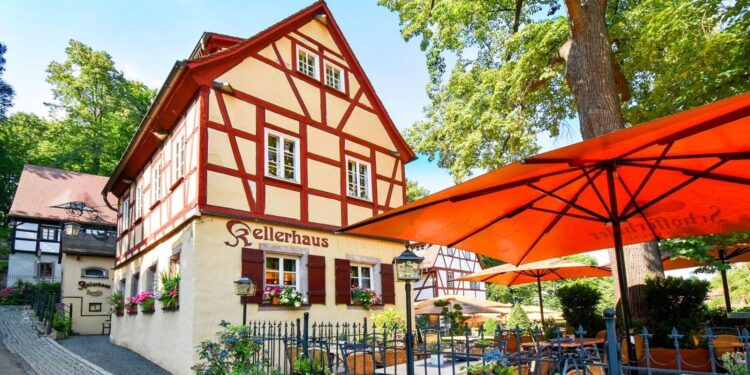Historical half-timbered house in Chemnitz, Germany.
getty
Every year since 1985, the European Union designates cities as European Capitals of Culture, a title aimed at celebrating the rich cultural diversity of Europe while fostering unity and international cooperation. This initiative encourages cities to showcase their unique cultural heritage, modern creativity and community projects to a wider audience.
In 2025, two lesser-known regions have been chosen to share this prestigious title: the city and surrounding region of Chemnitz, Germany and the twin cities of Nova Gorica and Gorizia, which straddle the border of Slovenia and Italy.
Together, they represent a bridge between past and future, and across national borders.
Chemnitz, Germany: City Of Makers
Nestled in the heart of Saxony, Chemnitz is a city with a rich industrial past, often called the “Saxon Manchester” for its role during the Industrial Revolution.
Part of the ‘double town hall’ in the historic center of Chemnitz, Germany.
getty
Heavily destroyed during World War II and later shaped by its time under East German rule, Chemnitz has undergone change after change. Its 2025 Capital of Culture motto, “C the Unseen,” reflects the city’s mission to bring to light the often overlooked aspects of its culture, architecture, and communities.
Chemnitz, Zwickau, and the surrounding region have played a key role in Germany’s industrial growth, particularly in textiles, engineering, railroads, and automotive industries. Mining in the Ore Mountains once made it an economic powerhouse.
Since 2019, the Erzgebirge/Krušnohorí mining region has been a UNESCO World Heritage Site. The area boasts museums, unique architecture and numerous medieval, Renaissance and Baroque castles.
Chemnitz itself is known for its historical sites, from art nouveau buildings to Soviet-era monuments like the massive Karl Marx Monument, which stands as a reminder of the city’s complex past.
The Karl Marx monument in Chemnitz remembers the city’s complex past.
getty
One of the city’s notable features is its focus on community involvement and grassroots initiatives, such as local people planting thousands of apple trees.
In 2025, visitors will be invited to explore a city that has turned its industrial past into a platform for artistic expression. Garages that once stored machinery are now transformed into creative spaces, and the city’s parks will host festivals, performances, and exhibitions.
Meanwhile, Chemnitz’s Purple Path is an expansive art and sculpture trail connecting the city with 38 partner municipalities, emphasizing the importance of regional collaboration.
From indie music festivals to street art, Chemnitz’s subcultures will also come into focus, as part of its effort to foster a cosmopolitan, democratic future in the face of recent challenges. The organizers hope the themes of inclusion, democracy, and unity will offer a fresh narrative for the city in the years to come.
Nova Gorica And Gorizia: A Borderless Celebration
While Chemnitz focuses on unveiling the unseen, the joint designation of Nova Gorica in Slovenia and Gorizia in Italy represents a celebration of unity across borders.
The Soca River will host play host to events during Nova Gorica and Gorizia’s year in the spotlight.
getty
These twin cities share not only a geographical location but also a complex history. Situated at the crossroads of Slavic and Italian cultures, this region was once divided by the Iron Curtain during the Cold War. Today, it serves as a living example of the power of European integration.
The 2025 Capital of Culture for these two cities will carry the slogan “GO! Borderless,” symbolizing their commitment to breaking down barriers, both literal and metaphorical.
The unique cross-border nature of this Capital of Culture brings together two nations and multiple cultures, all set against the stunning natural backdrop of the Soča River Valley and the Julian Alps.
Tijana Boric (Tish) is among the event’s ambassadors and performers that were raised in Nova Gorica. “It’s easy to find Serbian or Slovenian food and hear people speaking Slovenian, English, Serbian and Croatian. Being so close to Italy adds another layer of cultural richness,” she told the BBC.
One of the most exciting aspects of the Nova Gorica-Gorizia celebration is the multimedia and performance art set in natural landscapes. Visitors can expect to experience performances in extraordinary locations, thought-provoking installations, and workshops on technology, innovation, and language for a borderless world.
Aerial view of Gorizia, Italy.
getty
These cities also plan to showcase the best of their natural environment, with ecological projects that include green corridors, urban forests, and spaces designed for biodiversity, such as insect hotels and meadows.
Nova Gorica and Gorizia will also highlight their culinary heritage through cross-border food events, including Tastes without Borders, which will unite Slovenian and Italian cuisine in a celebration of flavor and cultural fusion.
Why Visit The Capitals Of Culture?
For those unfamiliar with the concept, the European Capital of Culture title offers an invitation to experience European cities in new and unexpected ways.
For Chemnitz, it means discovering the untold stories of a city reborn from its industrial ashes. For Nova Gorica and Gorizia, it means witnessing the blending of borders and cultures in a truly unique setting.
The idea of elevating regional cities and towns to the world stage is a powerful reminder that culture thrives beyond major capitals like Berlin or Paris. These designated Capitals of Culture often reveal the untold stories of regions that, until now, might have been overshadowed.
As travel becomes more focused on authentic experiences, these lesser-known cities provide an opportunity for exploration beyond the typical European tourist hubs.
Visiting Chemnitz or the twin cities of Nova Gorica and Gorizia in 2025 offers the chance to see Europe through a different lens: one that celebrates diversity, history, and the power of cultural exchange.
MORE FROM FORBESForbesNorway’s Bodø Plans 1,000 Cultural Events In 2024By David NikelForbesWhat Europe’s Busiest Cities Are Doing To Combat Overtourism In 2024By David NikelForbesEurope Meets North America At Iceland’s Thingvellir National ParkBy David Nikel
Source link : http://www.bing.com/news/apiclick.aspx?ref=FexRss&aid=&tid=671acc4533404525b4fafa84f0bcc762&url=https%3A%2F%2Fwww.forbes.com%2Fsites%2Fdavidnikel%2F2024%2F10%2F24%2Fthese-are-the-european-capitals-of-culture-for-2025%2F&c=1589308589642536919&mkt=de-de
Author :
Publish date : 2024-10-24 15:37:00
Copyright for syndicated content belongs to the linked Source.




